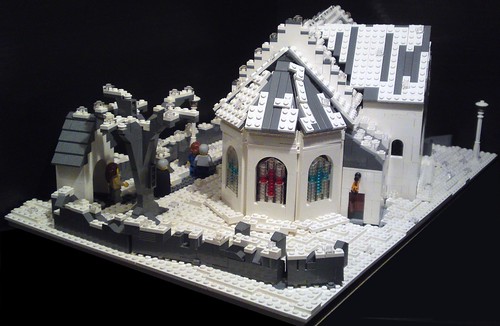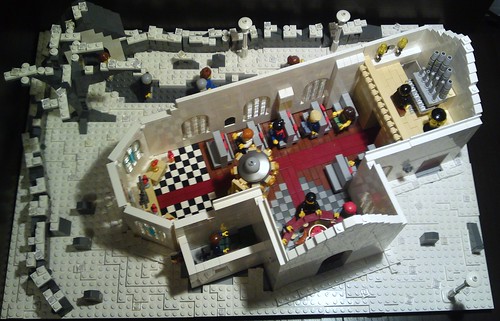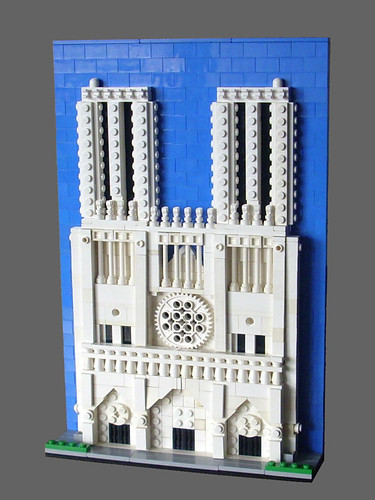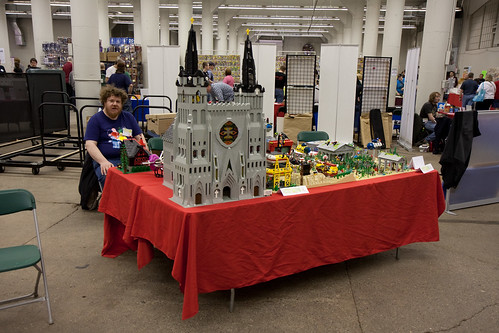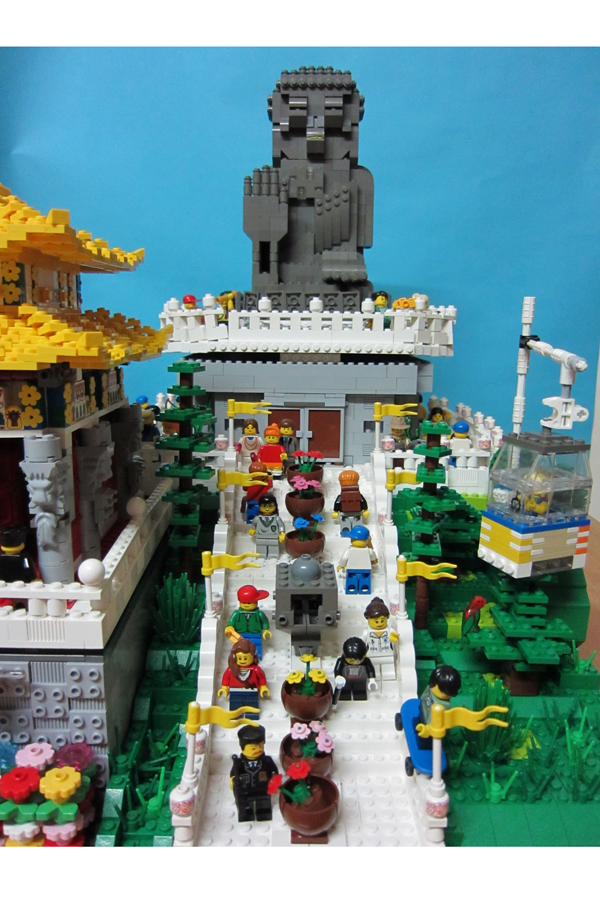
| Please visit the other 'Bricks' blogs: |
|
Saturday, July 31, 2010
Bigger Buddha
Still another entry from the Hong Kong LEGO contest Michael Lau has his own version of the Tian Tan Buddha.


Thursday, July 29, 2010
Big Buddha
In another entry for the Hong Kong LEGO contest, Chiukeung built a microscale version of Hong Kong, including the Tian Tan Buddha. This bronze statue, built during the 1990s, stands (well, sits) 34 meters high and weighs 250 metric tons. One of the halls beneath the statue holds a relic of Gautama Buddha, purported to contain some of his cremated remains.
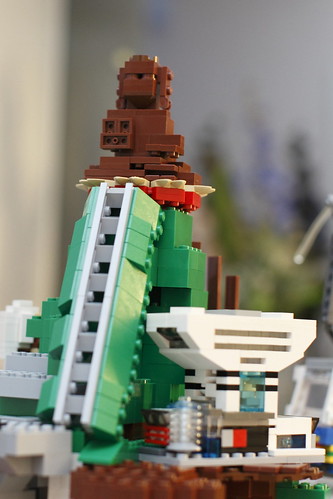

Tuesday, July 27, 2010
Make a wish!
CREATION K.O. Creation presents the Taipo Lam Tsuen Wishing Trees. Two banyan trees are located outside a temple to the goddess Tin Hau in Lam Tsuen. A supplicant will write their wish on a piece of paper, burn incense, and hang the wish from the branches of one of the trees in hopes of its fulfillment.
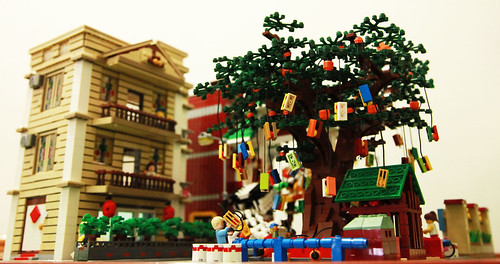
This is another entry in the Hong Kong LEGO contest, which has really been a great source for LEGO creations with themes from Eastern faiths.

This is another entry in the Hong Kong LEGO contest, which has really been a great source for LEGO creations with themes from Eastern faiths.
Sunday, July 25, 2010
Now that's a lot of Buddhas
Antony Lau created another entry for the LEGO Hong Kong contest, the Ten Thousand Buddhas Monastery. Built in Shat Tin between 1949 and 1957, this Buddhist Temple (not a true monastery), is famed for housing more than 12,000 statues of Buddha, ranging from very small to very large.


Wednesday, July 21, 2010
Wong Tai Sin Temple
The Wong Tai Sin Temple in Hong Kong is a Taoist shrine dedicated to the great immortal Wong. Born in 338, Wong practiced Taoism and became revered as a great man during his life and was later considered a god. It was only around 1900, though, that his influence spread. This temple was built in 1921 and is a popular site in Hong Kong, both for penitents and tourists.

Visitor to the temple offer burning sticks of incense and prayers at the altar to Wong Tai Sin.

One of the traditions practiced at the temple is Kau Cim, a form of an oracle where petitioners ask a question of the gods and then shake a container of bamboo sticks until one falls out. Each stick is numbered, and the number points to a fortune that can be interpreted to answer the question (though often with the help of a temple priest).
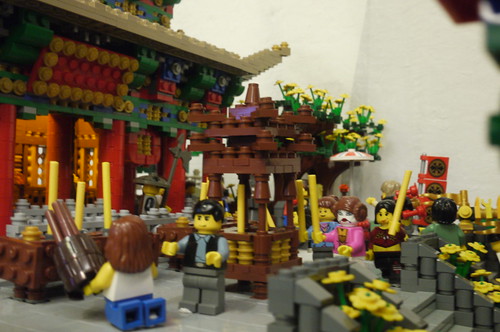
Andy Hung's LEGO rendition of the Wong Tai Sin Temple is an entry in a contest featuring various Hong Kong scenes by several AFOLs. Seen via the Brothers-Brick.

Visitor to the temple offer burning sticks of incense and prayers at the altar to Wong Tai Sin.

One of the traditions practiced at the temple is Kau Cim, a form of an oracle where petitioners ask a question of the gods and then shake a container of bamboo sticks until one falls out. Each stick is numbered, and the number points to a fortune that can be interpreted to answer the question (though often with the help of a temple priest).

Andy Hung's LEGO rendition of the Wong Tai Sin Temple is an entry in a contest featuring various Hong Kong scenes by several AFOLs. Seen via the Brothers-Brick.
Monday, July 19, 2010
Milton
Of Mans First Disobedience, and the Fruit
Of that Forbidden Tree, whose mortal tast
Brought Death into the World, and all our woe,
With loss of Eden, till one greater Man
Restore us, and regain the blissful Seat,
Sing Heav'nly Muse.
Thus begins Paradise Lost, the masterpiece of John Milton.

GEEK ASiA rendered a great number of famous figures in LEGO form, including Milton.
Of that Forbidden Tree, whose mortal tast
Brought Death into the World, and all our woe,
With loss of Eden, till one greater Man
Restore us, and regain the blissful Seat,
Sing Heav'nly Muse.
Thus begins Paradise Lost, the masterpiece of John Milton.

GEEK ASiA rendered a great number of famous figures in LEGO form, including Milton.
Thursday, July 15, 2010
Buddha Bracelet
In Buddhism, prayer beads are used as an aid to meditation. The practitioner turns a string of beads in their hand as they repeat a mantra, as a way of counting their repetitions while still being able to focus on the mantra.

Chinese artist and activist Ai Weiwei created this piece, Buddha Bracelet, as part of Building Asia Brick by Brick, an exhibition of LEGO art and architecture that traveled through China and surrounding locations in 2007 and 2008.

Chinese artist and activist Ai Weiwei created this piece, Buddha Bracelet, as part of Building Asia Brick by Brick, an exhibition of LEGO art and architecture that traveled through China and surrounding locations in 2007 and 2008.
Tuesday, July 13, 2010
LEGO blogging
I started a topic on LEGO blogging over on Classic-Castle. I'd like to invite anyone, particularly if you have your own blog, to add your thoughts. If you're not a member of Classic-Castle, it's really easy to sign up, just fill in a few blanks and within a day a friendly site admin :) will approve you.
Monday, July 12, 2010
Shinto Shrine
Around 100,000 Shinto shrines can be found throughout Japan. These structures are built to house kami, or spirits. In some cases these are more personalized deities and in others they are more less defined, like the spirit of the forest, etc. One of the most obvious marks of a shrine is the Torii gate, that marks the entrance into a sacred area.

Andrew Becraft (of the Brothers-Brick) built this tiny shrine as part of a display he will be bringing to the upcoming BrickCon gathering of LEGO builders in Seattle. The theme of this convention is 'Big in Japan', and Andrew wanted to include a series of recognizable sites from around Tokyo.

Andrew Becraft (of the Brothers-Brick) built this tiny shrine as part of a display he will be bringing to the upcoming BrickCon gathering of LEGO builders in Seattle. The theme of this convention is 'Big in Japan', and Andrew wanted to include a series of recognizable sites from around Tokyo.
Thursday, July 8, 2010
Let freedom ring
Proclaim liberty throughout all the Land unto all the inhabitants thereof. Leviticus 25:10
That's the inscription on the Liberty Bell, rung in Philadelphia for many public pronouncements, including (at least in tradition - there is some historic question on this) on July 8, 1776, to summon the citizens to a public reading of the Declaration of Independence. This LEGO sculpture sits in the Philadelphia airport.
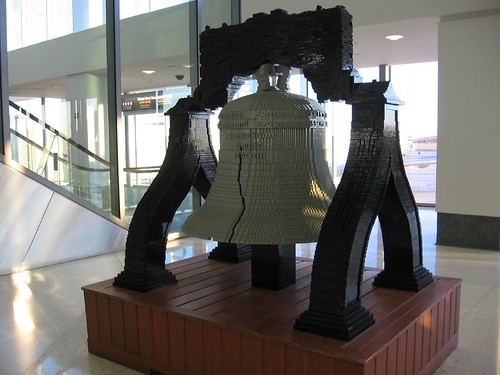
That's the inscription on the Liberty Bell, rung in Philadelphia for many public pronouncements, including (at least in tradition - there is some historic question on this) on July 8, 1776, to summon the citizens to a public reading of the Declaration of Independence. This LEGO sculpture sits in the Philadelphia airport.

Sunday, July 4, 2010
Happy Fourth of July
The US Constitution, the practical outline of our governmental institutions, is completely secular by design. However, the Declaration of Independence, the philosophical basis for the nation's founding, sets that foundation on the support of an undefined creator God.
...the laws of nature and of nature's God...
...they are endowed by their Creator with certain unalienable rights...
...with a firm reliance on the protection of Divine Providence...
Since the Declaration was signed on this date 234 years ago, the interplay between the secular and religious has been a key theme in public and legal life. Arthur Gugick built this great Independence Hall.

...the laws of nature and of nature's God...
...they are endowed by their Creator with certain unalienable rights...
...with a firm reliance on the protection of Divine Providence...
Since the Declaration was signed on this date 234 years ago, the interplay between the secular and religious has been a key theme in public and legal life. Arthur Gugick built this great Independence Hall.

Monday, June 28, 2010
When in Rome
Peggyjdb presents a great rendition of the Pantheon in Rome (this is actually a work-in-progress, as she intends to come back to the project and add the full dome). Built around 126 AD (after two earlier incarnations were each destroyed), this massive temple was devoted to all of the Gods of ancient Rome - i.e. Jupiter and company. The building was recommissioned as a Catholic church in 609 AD, which prevented it from falling into disrepair, though the interior has gone through many changes over the centuries. The structure also houses the tomb of Raphael and other prominent figures.
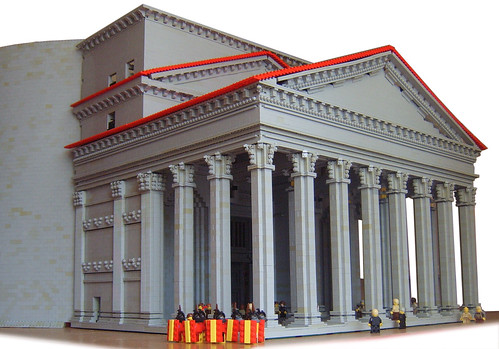

Tuesday, June 15, 2010
In the beginning . . .
Well, actually just back in 2001, Brendan Powell Smith started his Brick Testament project off with The Garden of Eden and five other illustrated stories from Genesis. He's gone back and redone this, breaking it into two parts: Creation and the Garden of Eden. Part of me asks why do this? Yes, there are many new elements that he uses here that were unavailable nine years ago, and Brendan's building has certainly improved over time, but those original scenes in Eden are so iconic to the Brick Testament that it seems they shouldn't have been touched (e.g. the scene with the Kaadu and Jar-Jar among the created animals). You can compare the old and the new on this page. And the original will always be with us in book form, so let's go on and look at these new iterations with fresh eyes.
Creation - Some nice bits in the start with the differences between dark and light and God lifting up the sky. Having God float over the creation scenes is a nice decision, presumably achieved via Photoshop layering. Genesis 1:10, the creation of land, is a great example of this. I'm really curious as to what piece is used for the sun here, some lid? And the moon and stars are great (and nice to bracket the story, as he uses a very similar technique in Revelations). Genesis 1:21 with the fish and birds is well done and along with Genesis 1:24-25, the creation of animals, shows how many more LEGO animals are available than when the Brick Testament began. Hey, there's the Kaadu! Now I'm happy again. Great new sheep design in 1:25. About the only non-LEGO aspect worth noting is 1:27, where God makes people, and Brendan chooses not to just make Adam and Eve, but a whole bunch of people. He comments on Flickr that he treated the Genesis 1 and 2 creation accounts separately, without trying to harmonize them. I do think it might have been better here to include racial diversity, with various flesh tone figs included, but perhaps there weren't blank torsos/hips/legs available in these other colors. The final scene, with God kicking back in a hammock on the seventh day, is priceless.

The Garden of Eden - This is generally well done and in keeping with the original version. I really like God building Adam up out of brown dirt, and then bringing him to life as a yellow fig. I'm really not a fan of the design of the Tree of the Knowledge of Good and Evil. I've tried using that stump element as the base for a tree before and come up short, and I'm afraid to say that Brendan's solution doesn't work for me here either. The Tree of Life, OTOH, has a very nice design. In 2:24, it's a little creepy to have God standing there while Adam and Eve get to know each other. In 3:7, I really like the way he's switched heads for Adam and Eve to the open-mouthed expressions, and then keeps these up for the next several scenes. Nice use of the brand new caveman torso for the newly clothed figs, and that last scene is great - especially the scraggly brown out-of-focus trees in the background.

By the way, Brendan also recreated Michelangelo's Creation of Adam, though it doesn't get used in either of these stories.
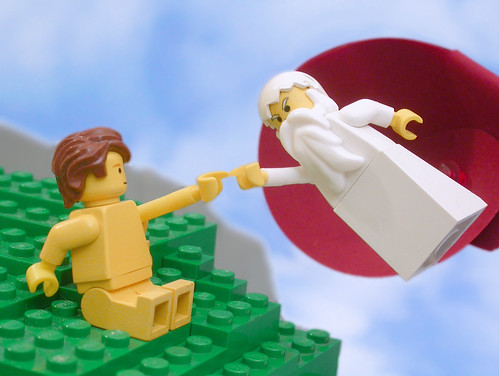
Creation - Some nice bits in the start with the differences between dark and light and God lifting up the sky. Having God float over the creation scenes is a nice decision, presumably achieved via Photoshop layering. Genesis 1:10, the creation of land, is a great example of this. I'm really curious as to what piece is used for the sun here, some lid? And the moon and stars are great (and nice to bracket the story, as he uses a very similar technique in Revelations). Genesis 1:21 with the fish and birds is well done and along with Genesis 1:24-25, the creation of animals, shows how many more LEGO animals are available than when the Brick Testament began. Hey, there's the Kaadu! Now I'm happy again. Great new sheep design in 1:25. About the only non-LEGO aspect worth noting is 1:27, where God makes people, and Brendan chooses not to just make Adam and Eve, but a whole bunch of people. He comments on Flickr that he treated the Genesis 1 and 2 creation accounts separately, without trying to harmonize them. I do think it might have been better here to include racial diversity, with various flesh tone figs included, but perhaps there weren't blank torsos/hips/legs available in these other colors. The final scene, with God kicking back in a hammock on the seventh day, is priceless.

The Garden of Eden - This is generally well done and in keeping with the original version. I really like God building Adam up out of brown dirt, and then bringing him to life as a yellow fig. I'm really not a fan of the design of the Tree of the Knowledge of Good and Evil. I've tried using that stump element as the base for a tree before and come up short, and I'm afraid to say that Brendan's solution doesn't work for me here either. The Tree of Life, OTOH, has a very nice design. In 2:24, it's a little creepy to have God standing there while Adam and Eve get to know each other. In 3:7, I really like the way he's switched heads for Adam and Eve to the open-mouthed expressions, and then keeps these up for the next several scenes. Nice use of the brand new caveman torso for the newly clothed figs, and that last scene is great - especially the scraggly brown out-of-focus trees in the background.

By the way, Brendan also recreated Michelangelo's Creation of Adam, though it doesn't get used in either of these stories.

Friday, June 11, 2010
Tuesday, June 8, 2010
Tuesday, June 1, 2010
Pisa
The Leaning Tower of Pisa, here depicted by Markmuel, is actually the bell tower, or campanile, of the Pisa Cathedral. The fact that the tower began to tilt soon after its construction really sealed its public image. It's in some ways too bad that the Tower gets so much attention to the extent that the Cathedral and the Baptistry, all built in the same plaza, get very little notice. I was actually there in 1991, a year after the Tower was closed to the public for a decade of restoration work, and all three structures are amazingly beautiful.


Saturday, May 29, 2010
Angkor Wat
Angkor Wat is surely the most recognizable site in Cambodia. It was first built as a Hindu temple over 800 years ago, and was later rededicated as a Buddhist temple. Here Arthur Gugick gives us a LEGO rendition.


Thursday, May 27, 2010
Madonna and child
On Flickr, Moosebot has developed what he calls midi-figs, LEGO characters at about half the size of a minifig. This month he's been presenting a new one each day, with a range of characters from knights in armor, to Star Wars characters, to comic book superheroes, to Neil Armstrong. Today he presents Mary and Jesus. BTW, if you follow that link, there's a discussion there about Catholic views on Mary and the saints.


Monday, May 24, 2010
LEGO: A Love Story
Hi. I'm posting a copy of this book review to each of my four blogs. However, if you read more than one of my blogs, I'm including a unique paragraph to the end on each blog noting specifics of the book relevant to the topic of that blog.
Review: A couple of years ago, I remember hearing on one of the LEGO forums about Jonathan Bender, a journalist who was planning on spending a year exploring the AFOL community as part of a writing project. He started a blog, Brick Bender, to document his journey. I read a few entries, but there are so many different blogs and websites out there that I kind of forgot about it. Recently, though, this exploration came to fruition in a new book, LEGO: A Love Story.

The result is a highly enjoyable book. Jonathan follows the journey that many of us took. He remembers playing with LEGO as a kid, but then goes into a long dark age. Little things remind him of his hobby, and eventually he digs his old bricks out of his parents' basement. He nervously buys new LEGO for himself, afraid that others might learn of his purchase. Then he starts building MOCs. He connects with the community, and is initially nervous that his MOCs won't measure up to the amazing models he sees.
Along the way, Jonathan met up with a great number of people from the AFOL community. One of the first things I noticed when flipping through the book was that it has a great index, and, yes, I looked myself up. To my utter surprise, delight, and honor, there I was. On page 106 he quotes something I posted on Lugnet several years ago about vignettes. But I'm a minor player, of course. He talks to a great number of the major players in the AFOL world, from bloggers to fest organizers, to current and former LEGO employees. He also researches the LEGO company and the growth of the fan community, with a lot of the major events along the way. He travels to several fan events like Brick World, Brick Bash, Brick Show, and BrickCon (hmm, see a pattern in fan fest names?) and gets behind the scenes tours at the Toy and Plastic Brick Museum, Legoland California, and the homeland itself, LEGO headquarters in Billund. And he invites us all along for the ride.
There are several audiences for this book. If you are just interested in the hobby as an outsider, particularly if you are, say, the spouse of an AFOL, he gives a great insight into these crazy people and their plastic brick masterpieces. If you are just coming out of your own dark age, you can learn a ton about the hobby and the people in it. If you're someone who's been in the hobby for years, it's like going to a reunion, where you encounter old friends and share great memories.
Are there shortcomings in this book? Yes, of course. No book can hope to be a comprehensive view of such a large and diverse community. I saw a couple of small errors, and places where I remember events a little differently than he reports. It felt in places like he gave a larger weight to some individuals because he got to know them personally, while other very important members of the community were missed, especially those outside the US. I do wish that he'd spent more time on the evolution of the on-line side of the Legoverse. He has a good picture of the growth from Usenet newsgroups to Lugnet. But as he reports, Lugnet is pretty dead these days, and he doesn't really go into the way that other, more specific forums grew out of Lugnet, or the variety of blogs (other than the Brothers Brick, which he rightly points out as the most important LEGO blog) and Flickr groups. The other thing I really felt the book needed was more pictures. There are black and white photos at the start of each chapter, and eight pages of glossy color photos in the center, but with such a visual medium you could have put photos on almost every page. As a pretty active AFOL I remember a lot of the different MOCs he mentions, but someone less involved in the hobby would benefit from photos of these. I want to reread the book with Jonathan's blog open in front of me, so that I can go back and forth and see his photos along with the events he describes.
The book is intensely personal. In addition to inviting us in to his own feelings as he becomes an AFOL - the fun of discovery, the nervousness about others learning about his hobby, the fear that his efforts would not be accepted by other AFOLs - he invites us deeper. We get to see him building LEGO with his dad as a child, and then again reconnecting through LEGO as an adult. Even more personally, we get his and his wife's fears that they may never have children of their own. I'm not afraid to admit that my eyes were tearing up at the emotional climax in the last few pages. This is ultimately a book about love. Yes, we all share a love for little plastic bricks, but in the end it is about love between people - the lasting friendships built up between community members, the love of a husband and wife, the love of a parent and child. That's what makes this hobby so special, and that's what this book celebrates.
GodBricks specific material: Jonathan has a discussion with Brendan Powell Smith about the Brick Testament. He also has a passing reference to these crosses produced by the LEGO company in their early years of molding plastic. He also talks with Brian Korte of Brickworkz, who has been featured here before.

Review: A couple of years ago, I remember hearing on one of the LEGO forums about Jonathan Bender, a journalist who was planning on spending a year exploring the AFOL community as part of a writing project. He started a blog, Brick Bender, to document his journey. I read a few entries, but there are so many different blogs and websites out there that I kind of forgot about it. Recently, though, this exploration came to fruition in a new book, LEGO: A Love Story.

The result is a highly enjoyable book. Jonathan follows the journey that many of us took. He remembers playing with LEGO as a kid, but then goes into a long dark age. Little things remind him of his hobby, and eventually he digs his old bricks out of his parents' basement. He nervously buys new LEGO for himself, afraid that others might learn of his purchase. Then he starts building MOCs. He connects with the community, and is initially nervous that his MOCs won't measure up to the amazing models he sees.
Along the way, Jonathan met up with a great number of people from the AFOL community. One of the first things I noticed when flipping through the book was that it has a great index, and, yes, I looked myself up. To my utter surprise, delight, and honor, there I was. On page 106 he quotes something I posted on Lugnet several years ago about vignettes. But I'm a minor player, of course. He talks to a great number of the major players in the AFOL world, from bloggers to fest organizers, to current and former LEGO employees. He also researches the LEGO company and the growth of the fan community, with a lot of the major events along the way. He travels to several fan events like Brick World, Brick Bash, Brick Show, and BrickCon (hmm, see a pattern in fan fest names?) and gets behind the scenes tours at the Toy and Plastic Brick Museum, Legoland California, and the homeland itself, LEGO headquarters in Billund. And he invites us all along for the ride.
There are several audiences for this book. If you are just interested in the hobby as an outsider, particularly if you are, say, the spouse of an AFOL, he gives a great insight into these crazy people and their plastic brick masterpieces. If you are just coming out of your own dark age, you can learn a ton about the hobby and the people in it. If you're someone who's been in the hobby for years, it's like going to a reunion, where you encounter old friends and share great memories.
Are there shortcomings in this book? Yes, of course. No book can hope to be a comprehensive view of such a large and diverse community. I saw a couple of small errors, and places where I remember events a little differently than he reports. It felt in places like he gave a larger weight to some individuals because he got to know them personally, while other very important members of the community were missed, especially those outside the US. I do wish that he'd spent more time on the evolution of the on-line side of the Legoverse. He has a good picture of the growth from Usenet newsgroups to Lugnet. But as he reports, Lugnet is pretty dead these days, and he doesn't really go into the way that other, more specific forums grew out of Lugnet, or the variety of blogs (other than the Brothers Brick, which he rightly points out as the most important LEGO blog) and Flickr groups. The other thing I really felt the book needed was more pictures. There are black and white photos at the start of each chapter, and eight pages of glossy color photos in the center, but with such a visual medium you could have put photos on almost every page. As a pretty active AFOL I remember a lot of the different MOCs he mentions, but someone less involved in the hobby would benefit from photos of these. I want to reread the book with Jonathan's blog open in front of me, so that I can go back and forth and see his photos along with the events he describes.
The book is intensely personal. In addition to inviting us in to his own feelings as he becomes an AFOL - the fun of discovery, the nervousness about others learning about his hobby, the fear that his efforts would not be accepted by other AFOLs - he invites us deeper. We get to see him building LEGO with his dad as a child, and then again reconnecting through LEGO as an adult. Even more personally, we get his and his wife's fears that they may never have children of their own. I'm not afraid to admit that my eyes were tearing up at the emotional climax in the last few pages. This is ultimately a book about love. Yes, we all share a love for little plastic bricks, but in the end it is about love between people - the lasting friendships built up between community members, the love of a husband and wife, the love of a parent and child. That's what makes this hobby so special, and that's what this book celebrates.
GodBricks specific material: Jonathan has a discussion with Brendan Powell Smith about the Brick Testament. He also has a passing reference to these crosses produced by the LEGO company in their early years of molding plastic. He also talks with Brian Korte of Brickworkz, who has been featured here before.

Monday, May 17, 2010
Subscribe to:
Posts (Atom)
